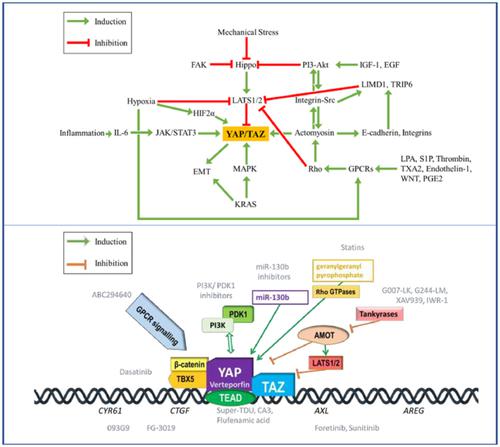当前位置:
X-MOL 学术
›
Neuropathol. Appl. Neurobiol.
›
论文详情
Our official English website, www.x-mol.net, welcomes your
feedback! (Note: you will need to create a separate account there.)
Emerging roles for the YAP/TAZ transcriptional regulators in brain tumour pathology and targeting options
Neuropathology and Applied Neurobiology ( IF 4.0 ) Pub Date : 2021-08-18 , DOI: 10.1111/nan.12762 Dimitrios Strepkos 1 , Mariam Markouli 1 , Kostas A Papavassiliou 1 , Athanasios G Papavassiliou 1 , Christina Piperi 1
Neuropathology and Applied Neurobiology ( IF 4.0 ) Pub Date : 2021-08-18 , DOI: 10.1111/nan.12762 Dimitrios Strepkos 1 , Mariam Markouli 1 , Kostas A Papavassiliou 1 , Athanasios G Papavassiliou 1 , Christina Piperi 1
Affiliation

|
The transcriptional co-activators Yes-associated protein 1/transcriptional co-activator with PDZ-binding motif (YAP/TAZ) have emerged as significant regulators of a wide variety of cellular and organ functions with impact in early embryonic development, especially during the expansion of the neural progenitor cell pool. YAP/TAZ signalling regulates organ size development, tissue homeostasis, wound healing and angiogenesis by participating in a complex network of various pathways. However, recent evidence suggests an association of these physiologic regulatory effects of YAP/TAZ with pro-oncogenic activities. Herein, we discuss the physiological functions of YAP/TAZ as well as the extensive network of signalling pathways that control their expression and activity, leading to brain tumour development and progression. Furthermore, we describe current targeting approaches and drug options including direct YAP/TAZ and YAP-TEA domain transcription factor (TEAD) interaction inhibitors, G-protein coupled receptors (GPCR) signalling modulators and kinase inhibitors, which may be used to successfully attack YAP/TAZ-dependent tumours.
中文翻译:

YAP/TAZ 转录调节因子在脑肿瘤病理学和靶向选择中的新兴作用
转录共激活因子 Yes 相关蛋白 1/具有 PDZ 结合基序的转录共激活因子 (YAP/TAZ) 已成为多种细胞和器官功能的重要调节因子,对早期胚胎发育产生影响,尤其是在扩张过程中的神经祖细胞池。YAP/TAZ 信号通过参与各种途径的复杂网络来调节器官大小发育、组织稳态、伤口愈合和血管生成。然而,最近的证据表明 YAP/TAZ 的这些生理调节作用与促癌活性有关。在这里,我们讨论了 YAP/TAZ 的生理功能以及控制其表达和活性的广泛的信号通路网络,从而导致脑肿瘤的发展和进展。此外,
更新日期:2021-08-18
中文翻译:

YAP/TAZ 转录调节因子在脑肿瘤病理学和靶向选择中的新兴作用
转录共激活因子 Yes 相关蛋白 1/具有 PDZ 结合基序的转录共激活因子 (YAP/TAZ) 已成为多种细胞和器官功能的重要调节因子,对早期胚胎发育产生影响,尤其是在扩张过程中的神经祖细胞池。YAP/TAZ 信号通过参与各种途径的复杂网络来调节器官大小发育、组织稳态、伤口愈合和血管生成。然而,最近的证据表明 YAP/TAZ 的这些生理调节作用与促癌活性有关。在这里,我们讨论了 YAP/TAZ 的生理功能以及控制其表达和活性的广泛的信号通路网络,从而导致脑肿瘤的发展和进展。此外,











































 京公网安备 11010802027423号
京公网安备 11010802027423号